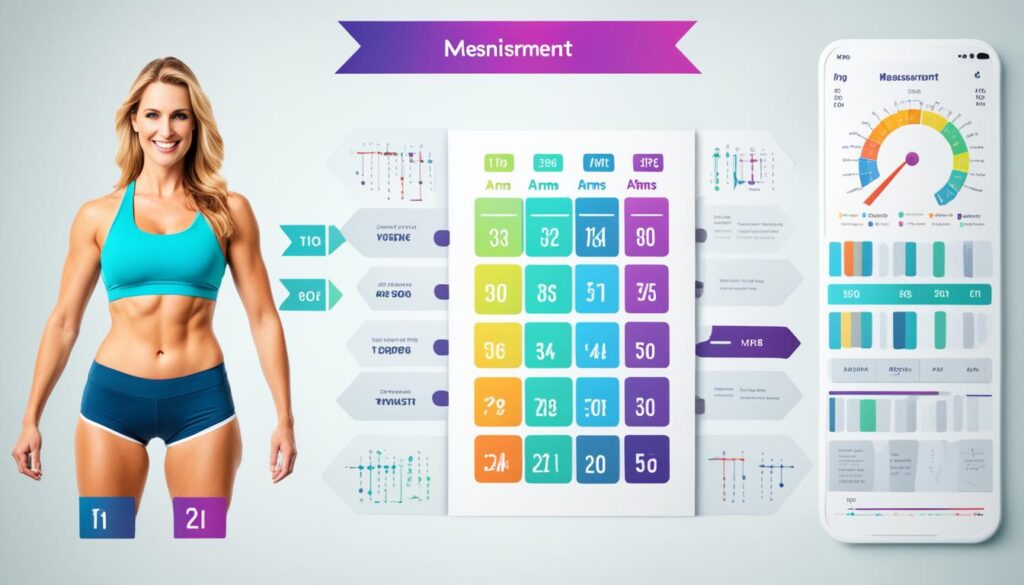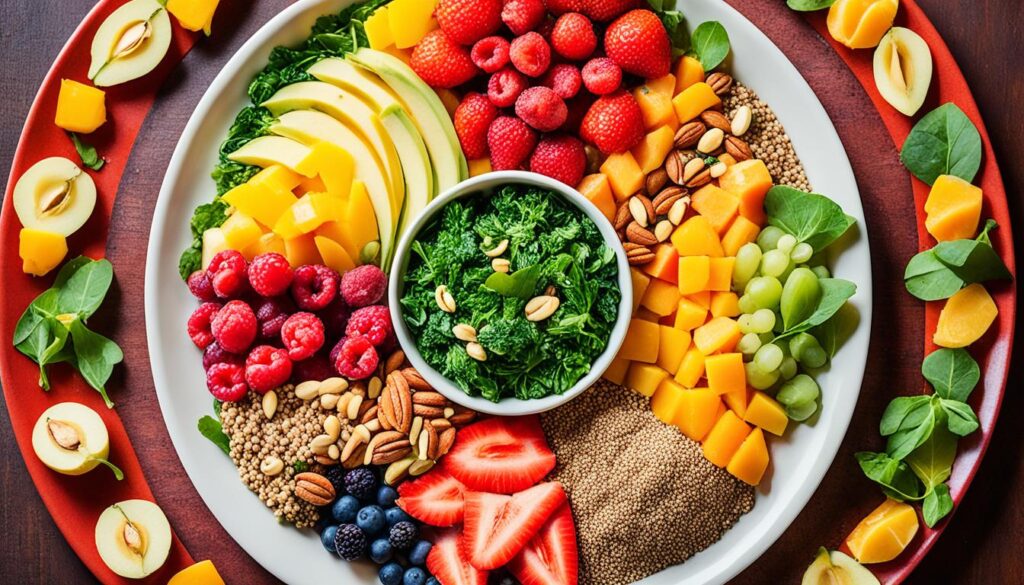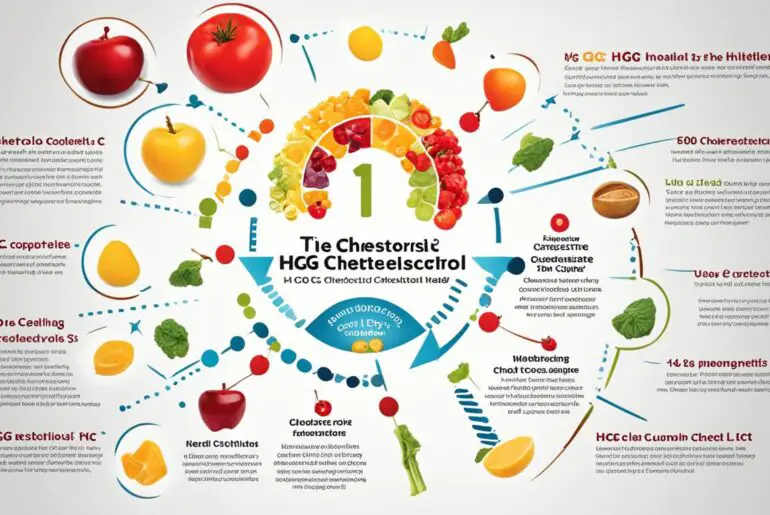Are you ready to kickstart your weight loss journey? Have you ever wondered why loading up on fatty foods is a crucial part of the HCG Diet? Contrary to popular beliefs, the “Start” phase of the HCG Diet, also known as Phase 1, involves gorging on high-fat and oily foods for a reason. But why? What purpose does this seemingly counterintuitive step serve? Let’s unravel the secrets behind Phase 1 of the HCG Diet and discover how it can set the stage for your weight loss success.
Key Takeaways:
- Phase 1 of the HCG Diet is crucial for priming the body for weight loss.
- Loading up on high-fat and oily foods helps prevent extreme hunger in the initial stages of the diet.
- Phase 2 focuses on fat burning with a low-calorie diet.
- Follow the recommended food list and guidelines strictly for optimal results.
- Plateau breakers and maintenance phase are important aspects to consider on the HCG Diet.
Phase 2 of the HCG Diet – Fat Burn
The Phase 2 of the HCG Diet, also known as the “Fat Burn” phase, is a critical part of the diet that lasts from day 3 to day 21. During this phase, individuals focus on a low-calorie diet while continuing with HCG injections or nasal spray. The goal is to trigger fat burning and achieve significant weight loss.
In Phase 2, individuals are required to consume only 500 calories per day, carefully selecting specific food choices. These choices typically include lean meats, such as chicken breast and white fish, vegetables like broccoli and spinach, specific fruits like apples and oranges, and a limited selection of starches.
It’s crucial to strictly follow the guidelines and avoid any foods that are not listed. By adhering to the prescribed food choices and calorie intake, the body enters a state of ketosis, where it primarily burns stored fat for energy. This fat-burning process helps individuals reach their weight loss goals effectively.
| Food Group | Food Choices |
|---|---|
| Protein | Chicken breast, white fish |
| Vegetables | Broccoli, spinach |
| Fruits | Apples, oranges |
| Starches | Grissini breadsticks, melba toast |
Following the Phase 2 HCG Diet, individuals can expect rapid weight loss. The combination of the low-calorie diet and the HCG hormone helps suppress hunger and supports metabolism, resulting in significant fat burning and improved body composition.
By sticking to the Phase 2 guidelines and maintaining discipline throughout, individuals can achieve their weight loss goals and lay a solid foundation for the subsequent maintenance phase of the HCG Diet.
Foods to Include and Avoid in Phase 2

During Phase 2 of the HCG Diet, it is essential to carefully choose the foods you consume. Following the recommended food list and avoiding prohibited items is crucial for achieving optimal results. In this phase, you should focus on lean proteins, specific vegetables, and limited fruits.
Allowed Foods:
- Lean Meats: Choose lean sources of protein such as skinless chicken breast, turkey, and white fish.
- Specific Vegetables: Include nutrient-rich vegetables like broccoli, spinach, cucumbers, and lettuce in your meals.
- Limited Fruits: Opt for low-sugar fruits such as apples, oranges, and strawberries. Remember to consume them in moderation.
These food choices provide essential nutrients while keeping your calorie intake within the recommended limits. They help support your body’s natural fat-burning process during Phase 2 of the HCG Diet.
Foods to Avoid:
- Oils: Avoid all types of oils, including cooking oils, salad dressings, and oil-based sauces.
- Sugars: Steer clear of added sugars, including table sugar, honey, maple syrup, and artificial sweeteners.
- Starches: Say no to bread, pasta, rice, potatoes, and other starchy foods.
Eliminating these foods from your diet is essential for maintaining the low-calorie intake required during Phase 2. It helps optimize the HCG Diet’s fat-burning effects and promotes successful weight loss.
Embrace the allowed foods and explore different combinations to create flavorful meals that adhere to the HCG Diet guidelines. Balancing proteins, vegetables, and fruits will ensure that you stay on track and make the most of Phase 2.
Plateau Breakers
During the HCG Diet, it’s common to experience plateaus where weight loss stalls or slows down. Breaking through these plateaus is essential to maintain progress and achieve your weight loss goals. Here are some effective strategies to overcome plateaus and jumpstart weight loss:
- Increase water intake: Staying hydrated is key to promoting weight loss. Aim to drink at least 8 glasses of water per day.
- Increase protein: Adding a small amount of extra protein to your meals can help boost your metabolism and break through plateaus.
- Apple day: Consuming only apples for a day can help reset your metabolism and kickstart weight loss. Choose organic, fresh apples for the best results.
- Cut down on beef: Beef can sometimes slow down weight loss. Try reducing your beef consumption or opting for leaner cuts of meat.
- Check condiments: Hidden sugars and additives in condiments can hinder weight loss. Read the labels carefully and choose condiments with no added sugars or artificial ingredients.
- Avoid mixing vegetables: Some individuals find that mixing certain vegetables can affect weight loss. Consider eating them separately to see if it makes a difference for you.
- Eliminate breadsticks: While breadsticks are allowed on the HCG Diet, eliminating them temporarily can help break through plateaus.
- Check protein sources: Ensure that your protein sources are free from additives or hidden sugars that can stall weight loss.
- Evaluate goal weight: Reassess your goal weight and consult with your healthcare provider to determine if you’ve reached a healthy weight. Adjusting your goal weight can provide a new perspective and motivation.
- Add moderate exercise: Incorporating moderate exercise, such as brisk walking or yoga, can help boost your metabolism and accelerate weight loss. Start with activities that suit your fitness level.
By implementing these plateau breakers, you can overcome weight loss plateaus and continue making progress on the HCG Diet.
| Plateau Breakers | Description |
|---|---|
| Increase water intake | Staying hydrated helps promote weight loss and maintains overall health. |
| Increase protein | Adding a small amount of extra protein boosts metabolism and aids in breaking through plateaus. |
| Apple day | A day of consuming only apples helps reset the metabolism and jumpstarts weight loss. |
| Cut down on beef | Reducing beef consumption or opting for leaner cuts can support weight loss efforts. |
| Check condiments | Reading labels and choosing condiments without added sugars or artificial ingredients prevents hidden obstacles to weight loss. |
| Avoid mixing vegetables | Eating vegetables separately can help identify any potential slowing effects on weight loss. |
| Eliminate breadsticks | Temporarily removing breadsticks from the diet can break through plateaus. |
| Check protein sources | Ensure protein sources are free from additives or hidden sugars that can hinder weight loss. |
| Evaluate goal weight | Reassessing the goal weight with professional guidance maintains realistic expectations and motivation. |
| Add moderate exercise | Incorporating moderate exercise boosts metabolism and accelerates weight loss. |
Phase 3 – Maintenance Phase

After completing Phase 2 of the HCG Diet, individuals enter Phase 3, also known as the Maintenance Phase. This three-week period is crucial for stabilizing weight loss and establishing healthy eating habits. During Phase 3, participants have more flexibility in their food choices, but there are still some important guidelines to follow.
In Phase 3, individuals are allowed to eat anything they please, except for sugar and starch. This freedom allows for a wider variety of foods and gives individuals the opportunity to reintroduce different flavors and textures into their meals. However, it is essential to continue weighing oneself daily to ensure that weight is maintained within a specific range.
To maintain metabolic function and customize the metabolic balance with the new weight achieved during Phase 2, it is advised to increase calorie intake to around 1500-2000 calories per day. This increase in calories helps prevent the body from going into starvation mode and encourages the body to maintain its metabolic rate.
During Phase 3, it is important to prioritize healthy food choices. By selecting nutrient-dense foods, individuals can support their overall health and well-being. Filling meals with lean proteins, leafy greens, colorful vegetables, and healthy fats can provide essential nutrients while keeping calorie intake in check.
Image:
Table: Foods to Include and Avoid in Phase 3
| Foods to Include | Foods to Avoid |
|---|---|
| Lean proteins (chicken, turkey, fish, lean cuts of beef) | Sugar |
| Leafy greens (spinach, kale, lettuce) | Starchy vegetables (potatoes, corn, peas) |
| Colorful vegetables (bell peppers, broccoli, cauliflower) | Processed foods |
| Healthy fats (avocado, olive oil, nuts) | Highly processed or refined oils |
| Fruits (berries, citrus fruits) | White bread and pastries |
By following the guidelines of Phase 3, individuals can transition to a more balanced and sustainable way of eating. This phase sets the foundation for long-term weight maintenance and offers the opportunity to develop healthier habits that can be carried beyond the HCG Diet.
Exercise and Sleep during the HCG Diet
Maintaining a healthy exercise routine and getting adequate sleep are important factors to consider during the HCG Diet. By incorporating exercise and prioritizing quality sleep, you can enhance your weight loss journey and overall well-being.
Exercise during the HCG Diet
Moderate exercise is recommended during the HCG Diet. However, the intensity and frequency of exercise should be based on your previous exercise levels and individual capabilities. If you find that you’re not achieving the desired weight loss while exercising, it is advisable to temporarily pause or reduce the intensity of your workouts while on the diet. This will allow your body to focus on burning stored fat and optimizing weight loss.
When engaging in exercise during the HCG Diet, consider incorporating activities that raise your heart rate and promote calorie burn. Brisk walking, yoga, or light cardio workouts are great options to get your body moving and increase your metabolic rate. Aim to integrate these activities into your routine a few times a week, alongside the recommended low-calorie diet, to maximize your weight loss potential.
Sleep during the HCG Diet
Getting sufficient sleep is not only crucial for overall health but can also support weight loss efforts. When you consistently get a good night’s sleep, your body is better equipped to regulate appetite hormones and manage cravings, reducing the likelihood of overeating or making poor food choices.
During the HCG Diet, it is recommended to establish a consistent sleep schedule and aim for 7-9 hours of quality sleep each night. This will help your body recover, recharge, and support the weight loss process. Additionally, maintaining a regular sleep routine can help improve your overall energy levels and mental focus during the day.
Remember to weigh yourself at the same time each day to track your progress accurately. Consistency with your sleep patterns and exercise routine, alongside the HCG Diet program, can provide optimal results for achieving your weight loss goals.
| Exercise Tips during the HCG Diet | Sleep Tips during the HCG Diet |
|---|---|
|
|
Tracking Progress and Measurement Charts

To successfully monitor your progress on the HCG Diet, it’s crucial to track your weight and body measurements regularly. By doing so, you can stay motivated, measure the effectiveness of the diet, and make adjustments when necessary. Here’s how you can track your progress and use measurement charts to visually track your transformation.
Weigh Yourself Daily
One of the most important aspects of tracking your progress on the HCG Diet is weighing yourself daily. Use a reliable scale and record your weight every morning before eating or drinking anything. This consistent daily tracking will provide a clear picture of your weight loss journey.
Record Your Weight on a Tracking Chart
To keep a record of your weight loss progress, create a tracking chart or use a printable HCG Diet tracking chart available online. By plotting your daily weights on the chart, you’ll be able to observe patterns, fluctuations, and the overall trajectory of your weight loss.
| Date | Weight |
|---|---|
| Day 1 | 150 lbs |
| Day 2 | 148 lbs |
| Day 3 | 146 lbs |
Measure Inches Lost with Measurement Charts
In addition to tracking your weight, measuring inches lost in various body areas can provide a more comprehensive view of your progress. Measurement charts can help you track changes in your bust, waist, hips, inner thigh, biceps, and more. Use a flexible measuring tape and measure each body area at the start of the diet and then at regular intervals throughout your journey.
Stay Motivated and Track Changes in Body Composition
Completing measurement charts regularly can serve as a powerful motivational tool. As you see inches melting away and your body shape transforming, it will reinforce your dedication to the HCG Diet. Remember, weight loss is not the only measure of progress; changes in body composition are equally important.
By diligently tracking your progress and using measurement charts, you can celebrate your achievements, identify areas for improvement, and stay on track to achieve your weight loss goals on the HCG Diet.
Tips for Successful HCG Diet

Embarking on the HCG Diet requires mental preparation and a commitment to achieving your weight loss goals. To increase your chances of success, consider the following tips:
- Create an inventory of compliant foods: Take the time to research and compile a list of foods that are allowed on the HCG Diet. Having this inventory at hand will make grocery shopping and meal planning easier.
- Prepare meals ahead of time: Plan your meals in advance and prepare them in bulk if possible. This will save you time and help you stay on track, even when you’re short on time or feeling tempted to deviate from the diet.
- Understand the diet requirements and allowances: Familiarize yourself with the guidelines of the HCG Diet, including the required water consumption, options for coffee and tea, recommended seasonings, and permissible sweeteners. Having a clear understanding of the diet will prevent any missteps.
- Break through weight plateaus: Plateaus can be discouraging, but they are not uncommon during weight loss journeys. To overcome plateaus on the HCG Diet, consider increasing your water intake, evaluating portion sizes, and incorporating gentle exercise into your routine.
“Success is not the key to happiness. Happiness is the key to success. If you love what you are doing, you will be successful.” – Albert Schweitzer
By implementing these tips and staying dedicated to the HCG Diet, you can increase your chances of achieving your weight loss goals and experiencing success on your journey.
Clean Loading Option for Phase 1

During Phase 1 of the HCG Diet, individuals have the option to explore clean loading as an alternative approach. Clean loading focuses on consuming high-fat, nutritious foods instead of indulging in unhealthy, sugary foods typically associated with traditional loading. By making smart food choices and avoiding processed foods, sugars, and high-carbohydrate options, clean loading provides a healthier start to the diet while still allowing individuals to load on essential fats and nutrients.
Clean loading during Phase 1 of the HCG Diet offers several benefits. By avoiding sugary and processed foods, individuals can prevent excessive spikes in blood sugar levels, which can lead to cravings and energy crashes. Instead, clean loading emphasizes whole, nutrient-dense foods that provide sustained energy and satiety throughout the loading phase.
Some examples of clean loading options include:
- Avocado
- Nuts and seeds
- Fatty fish like salmon
- Olive oil
- Coconut oil
- Eggs
- Full-fat dairy products
By incorporating these high-fat, nutritious foods into the loading phase, individuals can nourish their bodies while still priming it for Phase 2 of the HCG Diet.
Remember, clean loading is an alternative option. Traditional loading, which involves indulging in high-fat, oily foods, is still a valid approach. Choose the method that aligns best with your goals, preferences, and health considerations.
Now let’s take a look at a visual representation of the clean loading option:
| Food | Description |
|---|---|
| Avocado | Rich in healthy fats, fiber, and various vitamins and minerals. |
| Nuts and Seeds | Provide essential fatty acids, protein, and other nutrients. |
| Fatty Fish | High in omega-3 fatty acids, which are beneficial for heart health. |
| Olive Oil | A source of monounsaturated fats, antioxidants, and anti-inflammatory properties. |
| Coconut Oil | Rich in medium-chain triglycerides, which can boost metabolism. |
| Eggs | Provide high-quality protein, essential fats, and various nutrients. |
| Full-Fat Dairy Products | Contain healthy fats, protein, vitamins, and minerals. |
Conclusion
The HCG Diet Phase 1 Detailed Guide provides a comprehensive overview of the HCG Diet, specifically focusing on Phase 1, also known as the loading phase. This phase is crucial for priming the body and preparing it for the subsequent phases of the diet. By loading on high-fat and oily foods and starting HCG injections or nasal spray, individuals can set themselves up for success in achieving their weight loss goals.
The guide also delves into Phase 2, where the focus shifts to fat burning. By following a low-calorie diet and adhering to specific food choices, such as lean meats, vegetables, fruits, and limited starches, individuals can continue their weight loss journey. Additionally, Phase 3, the maintenance phase, is discussed, emphasizing the importance of customizing the metabolic balance achieved in Phase 2 and incorporating healthy food choices while avoiding sugar and starch.
To ensure success on the HCG Diet, the guide offers valuable tips, including ways to break through plateaus, the importance of moderate exercise and adequate sleep, and the significance of tracking progress. Additionally, it provides an alternative option for Phase 1, known as clean loading, where individuals can make healthier food choices during the loading phase.
Following the HCG Diet protocol can lead to successful weight loss and improved health. By implementing the strategies outlined in the guide and maintaining a disciplined approach throughout the different phases of the diet, individuals can achieve their desired results and embark on a journey towards a healthier lifestyle.
FAQ
What is Phase 1 of the HCG Diet?
Phase 1 of the HCG Diet, also known as the “Start” phase, involves loading on high-fat and oily foods while starting HCG injections or nasal spray. This phase typically lasts for two days and is important for priming the body for the next phase of the diet.
How long does Phase 2 of the HCG Diet last?
Phase 2 of the HCG Diet, also known as the “Fat Burn” phase, lasts from day 3 to day 21. During this phase, individuals consume only 500 calories per day while continuing with HCG injections or nasal spray.
What foods are allowed during Phase 2 of the HCG Diet?
During Phase 2 of the HCG Diet, individuals are allowed to consume lean meats like chicken breast and white fish, specific vegetables such as broccoli and spinach, and limited fruits like apples and oranges. It is important to avoid foods that are not listed and also eliminate oils, sugars, and starches.
How can plateaus be overcome during the HCG Diet?
Plateaus during the HCG Diet can be overcome by increasing water intake, increasing protein by a small amount, consuming only apples for a day, cutting down on beef, checking condiments for hidden sugars, avoiding mixing vegetables, eliminating breadsticks, checking for additives in protein sources, evaluating if the goal weight has been reached, and considering adding moderate exercise.
What is Phase 3 of the HCG Diet?
Phase 3 of the HCG Diet, also known as the “Maintenance Phase,” is a three-week period after completing Phase 2. During this phase, individuals can eat anything they please, except for sugar and starch, as long as they continue to weigh themselves daily and maintain a calorie intake of 1500-2000 calories per day.
Is exercise recommended during the HCG Diet?
Moderate exercise is recommended during the HCG Diet, based on previous exercise levels. However, if the desired weight loss is not being achieved, it is advisable to temporarily stop exercising while on the diet. Adequate sleep is also important for weight loss and overall health.
How can progress be tracked during the HCG Diet?
To track progress during the HCG Diet, individuals should weigh themselves daily and record the weight on a tracking chart. Measurement charts are also available to measure inches lost in various body areas. These measurement charts can provide a visual representation of progress throughout the diet.
What are some tips for success on the HCG Diet?
To ensure success on the HCG Diet, mental preparation is crucial. Setting goals, creating an inventory of compliant foods, and preparing meals ahead of time can help in staying on track. It is also important to understand the diet requirements and allowances and follow the guidelines strictly.
What is clean loading in Phase 1 of the HCG Diet?
Clean loading is an alternative option for Phase 1 of the HCG Diet, where individuals focus on consuming high-fat, nutritious foods instead of indulging in unhealthy, sugary foods. This approach can help individuals feel satiated and energized during the loading phase while providing a healthier start to the diet.
What is the purpose of the HCG Diet Phase 1 Detailed Guide?
The HCG Diet Phase 1 Detailed Guide provides a comprehensive overview of Phase 1, also known as the loading phase, of the HCG Diet. It explains the importance of loading on high-fat and oily foods while starting HCG injections or nasal spray. The guide also includes tips for successful dieting, ways to break through plateaus, and clean loading options for Phase 1.




